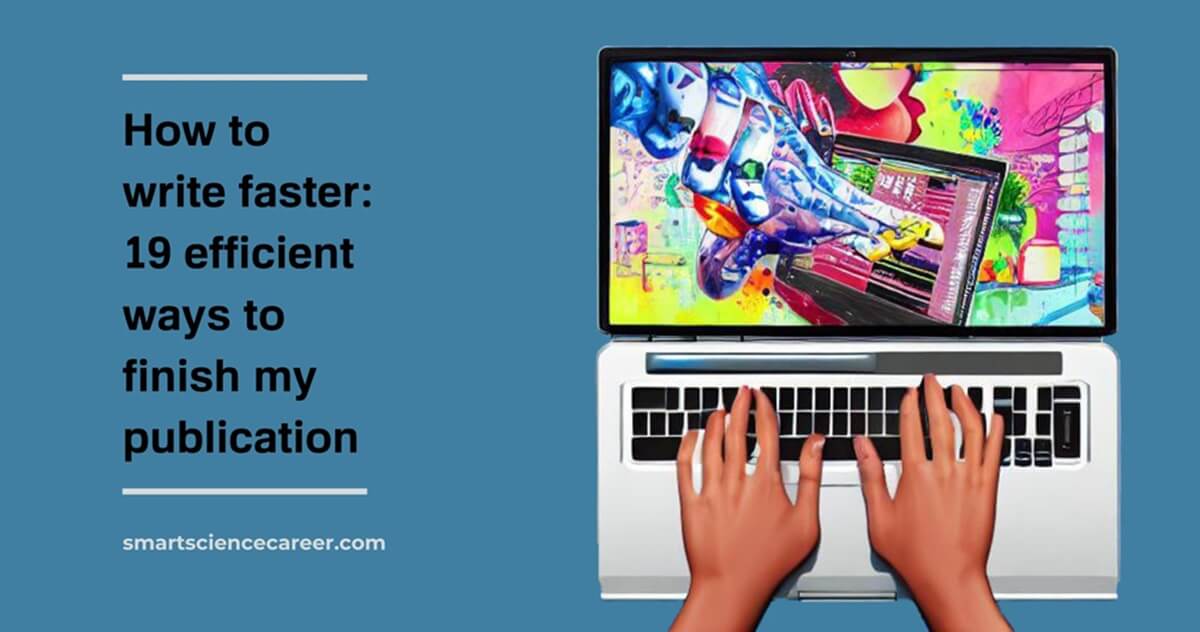How to write faster: 19 efficient ways to finish my publication
Writing a research paper or a review can be a pleasure or a pain. If you manage your energy and time well, you can dramatically speed up your writing. What are the best tips and easy steps to write a research paper faster and more efficiently?
For young scientists, it is always challenging to develop the best publication strategy. For a successful career in science, you have to publish with high-impact factors and in sufficient quantity. Thus, you have to learn how to write more efficiently to create more high-quality output.
There are many posts on social media with general writing tips that may be helpful. These tips include taking sufficient breaks, having a good posture or a standing desk during writing, avoiding distractions by apps or other persons, using the pomodoro technique, and breaking down large projects into smaller components.
The standard tips include increasing your handwriting speed by using fountain pens with the best tip size or your typing speed by using alternative word processors.
In this article, I will provide a specific list of tips to reduce the writing time of scientific publications.
Tip 1: Make a quick writing plan
It sounds counterintuitive – but do *not* start with the actual writing. As the first thing, quickly choose your writing tasks. Decide what you want to write and for how long, and define the end result.
For example, put a designated time for writing sessions in your calendar with specific tasks, such as “8 am to 9 am: Writing the figure legends”. Whether you are an early bird or a night owl, the main thing is to reserve time in your calendar.
Not booking time makes you a slow writer. If you give yourself a specific but limited time to write, you are motivated to use this period well.
Tip 2: Develop a writing and editing habit
If you need your willpower to start writing, you will often fail when real life interferes. Developing routines that work rather automatically exclude the willpower element and make you fast. If you write every day at the same time, it becomes easy.
It is also helpful to have a specific editing routine to set aside time to review and revise your work after you have completed a draft. Additionally, seeking feedback from others and using a pre-submission checklist (see below) should be part of the routine.
Furthermore, create your personal infrastructure to make writing pleasurable. Choose a great place that you like. Some may prefer a coffee shop, and others a hut in the woods. Writing in a shared office with 3 chatting PhD students may not be the right choice.
Choose the time of day when your energy levels are high. Inform your colleagues that this is your writing time and kindly ask them not to interrupt you. Do not answer when your phone rings. Better switch it off.
If you want to learn more about developing a writing routine, let me suggest this book: “The Miracle Morning for Writers: How to Build a Writing Ritual That Increases Your Impact and Your Income (Before 8 am)” by Hal Elrod (affiliate link).
Tip 3: Track your word count
What gets measured can be improved. Fast writing is a skill that can be trained. Therefore, tracking your word count in every work session may stimulate your writing speed. I use a simple Excel spreadsheet to document the time I have invested and the words I have written.
You can easily track the number of words and pages in Microsoft Word or Google docs. Measuring my word count is the best method to reach my writing goals and strengthen my daily writing habit.
If you want to become a faster writer and increase your writing speed dramatically, let me suggest my favorite book on the subject: “2k to 10k: Writing Faster, Writing Better, and Writing More of What You Love” by Rachel Aaron (affiliate link).
Tip 4: Do not start at the beginning!
Again, it sounds counterintuitive – do not start at the beginning! Thus, do not write the abstract and introduction first. I always write the abstract as the last step after I have well-defined conclusions in the discussion section.
In my experience, the best way to get a well-structured text is to inverse the order: Start with the easy parts (legends, results, materials & methods; see next tip), followed by the discussion section, and finally, the introduction.
It makes a lot of sense to write the introduction *after* you have discussed your interpretation of the data. If you do so, you write the introduction section with the general conclusion in mind, and your manuscript becomes much more consistent.
Tip 5: Write the easiest parts of your research paper first
To get momentum, always write the easiest parts of the text first in writing sprints. As a result, you quickly finish a big chunk of the publication, which motivates you to complete the rest. Choose the section which you find the most manageable.
This reduces unnecessary strain on your motivation and increases your output in record time. I usually start with the figure legends, the results, and the materials & methods section.
Tip 6: Use the figure legends as the starting point to structure your paper
Bring the figures in a preliminary order that reflects the “story” you want to tell. In the figure legends, quickly describe in easy terms what is visible in the figures (or tables) and what you want to highlight – for example: “In box 2, the area of interest is shown in a higher magnification”.
At the end of each legend, include a list of those abbreviations shown in the figure. Do the same with table legends.
This important step quickly reveals whether the order is self-explanatory and whether there are gaps in the story. Add a to-do list in the comments about missing figures, data, labels, arrows, etc. This to-do list reminds you of what to work on later. As a result, your writing flow does not get interrupted.
Tip 7: Write an unedited version of the results section
When the legends are ready, you may use them as a blueprint to write the results. To get a rough draft, explain the data in each figure comprehensively in a very readable way.
Do not force yourself to be perfect, and do not start to edit the text while writing to avoid interrupting your writing process. In later rounds, you shorten the manuscript to be more concise. This makes you a better writer.
Tip 8: Write the materials & methods section during lower-concentration times
Writing the materials & methods section is a rather administrative task but, unfortunately, very important for good science. You may not think that it is a great thing, but other scientists must be able to reproduce your findings. In addition, plagiarism investigators love to check your materials & methods section for mistakes.
Since the first step is administrative, you can prepare this section when you do not have the highest degree of concentration and creativity. Reserve these times for the quality content, thus, the discussion and introduction.
Often you can copy-paste from previous publications of your group or others because you use similar methods. Naturally, copy-paste mistakes are a risk. If you copy-paste from others, rewrite sufficiently and adapt the text to your lab practice to avoid plagiarism.
You may find it boring, but take a deep breath and write it quickly. In a second round, correct all mistakes and omissions with precision. A lot of writers suggest that separating the fast writing mode from the editing phase is a key method of how to write articles faster
Finally, let others check your work. Let co-authors check the description of the methods they have used for their contribution.
Tip 9: Create a skeleton and add the meat later
When writing the discussion and introduction section, create an outline first. Professional writers know, planning ahead before beginning any publication will save much time later. Outlines are blueprints that tell you precisely what to write next.
You never have a blank page or a blank screen. This is a great way to avoid writer’s block. You do not need a perfect, solid outline. A preliminary one that may change over time is sufficient.
For faster writing, create a list of subchapter titles and list the main points to address. You can easily add bullet points with the correct reference during the literature research phase to use less time for research.
It promotes good writing when most of the information is ready, and you only have to create a continuous text. There are many different ways to increase your output. However, having a well-structured outline is essential.
Tip 10: Use a reference management system to organize your references efficiently
Using a reference management system is obligatory to write fast. Such a system allows you to easily organize and manage your references, making it easier to find the ones you need when writing your article. You download the correct citation from a databank (for example, PubMed) as an easy way to avoid typos.
With a few shortcuts, you insert references into your document, and your reference list is updated while writing. Many reference management systems have built-in citation styles that automatically format your citations and bibliography in the correct style for your target journal. This can save you a lot of time and effort.
There are many reference management systems on the market. I have used ENDNOTE for many years, but there are also free alternatives.
Tip 11: Use a writing assistance tool to improve your writing style
The quality of your English in scientific publications influences your chances of getting positive reviews and getting published. If your English is of high quality, it can help your work stand out and be more easily understood by the reviewers and editors evaluating it.
I do not have a native English speaker among my staff members. Thus, I have to get help from a writing assistance tool. There are several writing tools on the market. I am a big fan of Grammarly. Using this app has dramatically increased my writing speed and the quality of my scientific writing in English.
As a non-native speaker, writing the English language is still challenging. Grammar checkers are not enough. Grammarly significantly improves my writing skills, including grammar, spelling, and punctuation. It also flags misspelled terms, formatting mistakes, passive voice, and sentences of excessive length or unclear structure.
Grammarly is seldom satisfied with my writing. Thus, I get a multitude of hints on writing more concisely. Grammarly just informed me that I should replace ’a multitude of’ with ‘many.’ But I want this sentence to be wordy. 😊
After using Grammarly or similar software for a while, you will never go back because you write so much faster.
Tip 12: Simplify your language and be concise
Always use accessible language and split long sentences to write faster and increase readability. Writing concise manuscripts that transport the complete message is a never-ending learning process.
Ernest Hemingway acknowledged it has taken his whole life to write in simple, concise prose. As a start, use Grammarly or similar programs to flag overlong sentences and complicated grammatical constructions.
Tip 13: Use artificial intelligence (AI) to inspire your writing
I am convinced that AI text generators will completely change scientific publishing. Many scientists are keen to use AI tools. However, you can write an entire blog post series or books about all the debates on the ethical implications and the potential downsides of AI processes in science.
The current AI systems are not fully functional enough to generate high-standard scientific texts. To the best of my knowledge, these systems have not yet been trained sufficiently on scientific manuscripts and therefore lack the necessary background to generate professional scientific content.
Furthermore, there have been numerous reports of plagiarism issues, the inclusion of fabricated statements in AI-generated texts, and a general absence of proper citations and references. However, the AI text generator cactus.ai can already produce essays that include some references.
Therefore, it is essential to note that – up to now – AI text generators such as ChatGPT or cactus.ai cannot cite sources or create a list of references with sufficient accuracy for scientific publications. Therefore, you will need to review the generated text carefully and manually add citations and references. I am convinced that this will change very soon.
However, ChatGPT suggests that “AI has the potential to streamline the research paper writing process by enabling rapid and accurate analysis of large amounts of data. For example, AI can be utilized to analyze experimental results and generate tables and graphs that can be incorporated into a paper more efficiently than if created manually.”
While we wait for AI text generators to improve, we can use them for two purposes:
- We can generate a rough draft of a paragraph for a review or the introduction or discussion section of a research paper. This draft should be treated as the work of an uneducated student and thoroughly rewritten, with all statements checked against the literature and adequately cited.
- We can let them rewrite scientific manuscripts that are poorly written, for example, by non-native speakers like me.
Tip 14: Let others write the first draft of the paper
When you are more advanced in your scientific career, you can ask your group members to write the first draft of the paper. Writing research publications and reviews is an essential skill to learn for young scientists such as PhD students and postdocs.
They have to learn how to present their own work in a convincing and readable way. They must learn to follow all the small hidden rules that make a study appear either professional or “shabby.” For example, they learn to use the correct format of abbreviations throughout the document or to distinguish clearly between results and interpretations.
I follow the simple rule that the first author writes most of the paper and takes care of formatting text, figures, and tables. I am convinced that receiving extensive feedback on these rough drafts is a good way for young scientists to learn to write better papers and to promote their science careers.
In my experience, the first drafts of a young scientist are usually terrible, and every page needs hundreds of corrections. In later projects, they start to know the rules and apply them automatically and produce their best work.
They know what I expect and are much faster. This is a lot of work for me initially, but it is worth it. Later, they write the first drafts of their studies much more quickly, and the amount of time for corrections is reduced.
You may think about hiring a freelance writer. Their services usually are pretty expensive, but they may substantially reduce your workload. Make sure to acknowledge their participation in the acknowledgment section but be prepared that some journals may have reservations. I have tried to work with two freelance writers but never published one of those texts.
Tip 15: Postpone editing until the following day
One way to finish a writing project faster is to stop writing and postpone editing until the following day. The main reason is to allow your brain to continue processing new ideas while you sleep, allowing them to “incubate” and silence the inner critic.
From personal experience, I have found that I have more clarity and can rewrite the manuscript more efficiently the next day. Additionally, taking a break and returning to the text with fresh eyes can help you approach it with a new perspective and accelerate the editing process.
Waiting a long time, such as several months or years, is counterproductive because you must start engaging again with the manuscript, and essential new references may be missing.
Tip 16: Get a lot of feedback from some authors early in the process
You may be inclined to wait until the last moment to give the manuscript to others for feedback. In contrast, I would suggest giving an early draft of the manuscript to your supervisor or a trustworthy colleague.
Ask them to highlight possible problems in the argumentation or presentation of the data to your target audience. If there are no significant flaws, this is good news. If you have to rewrite substantial parts of the manuscript, it is better to know this before you send the paper to all the co-authors. This helps to avoid unnecessary work and eliminates mistakes early in the process.
Tip 17: Get feedback from all authors in the last round
Before submitting the paper, try to get input from all authors. Some may spot tiny details, such as missing individual letters, and others may criticize the overall argumentation. Every bit helps to improve the document.
In some cases, you may have the impression to have fake authors in the authors’ list. However, if an author has not contributed substantially before, now is still a chance to let them contribute intellectually.
Tip 18: Check early which information you need for the submission
A classic mistake of young scientists is to wait until the submission date to check which information is requested by the target journal. Thus, before reaching the finish line, it is a good idea to check whether you have to provide additional information, such as a laymen’s summary in simple language or an overview of the essential findings in a few short bullet-point statements.
Tip 19: Develop a pre-submission checklist for the following publications
Finally, create a simple checklist to accelerate the process next time. Here is a short list of elements that typically get forgotten during the publishing process:
- Are all abbreviations explained the first time they are used?
- Are all symbols and abbreviations in the figures and tables explained in the legends?
- Do all labels in the figures have the same letter size?
- Is there an abstract and a laymen’s summary (if needed)?
- Are all helpful persons and all funding sources mentioned in the acknowledgments?
- Are all potential conflicts of interest disclosed by the co-authors?
These are just a few examples that illustrate why a checklist makes you faster.
Acknowledgments
I have used AI systems, including Grammarly, Google Gemini, Groq, and ChatGPT, to enhance the English and comprehensiveness of this article. This post may contain affiliate links, meaning I get a small commission if you decide to purchase through my link. Thus, you support smartsciencecareer at no cost to you!
Recommended reading
The following articles may also interest you:
- What is a substantial contribution to a paper?
- 28 Tips to Get More Citations for Your Publications
- How To Write Faster: 19 Efficient Ways To Finish My Publication
- Should I have senior authorships as a postdoc?
- Should I aim for co-authorships on high-impact papers?
- Should I aim for multiple co-authorships to extend my publication list?
- Should I publish negative results, or does this ruin my career in science?
- I have a fake author on my paper – what should I do?
- 10 simple strategies to increase the impact factor of your publication
- What is the best publication strategy in science?
- Is being a professor worth it?
- What is tenure?






